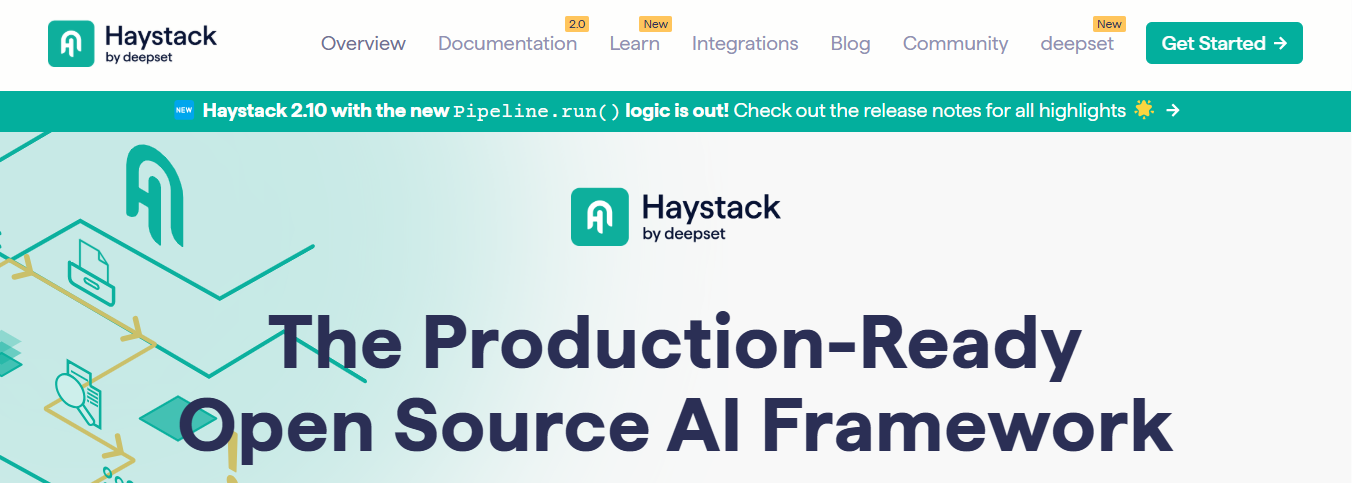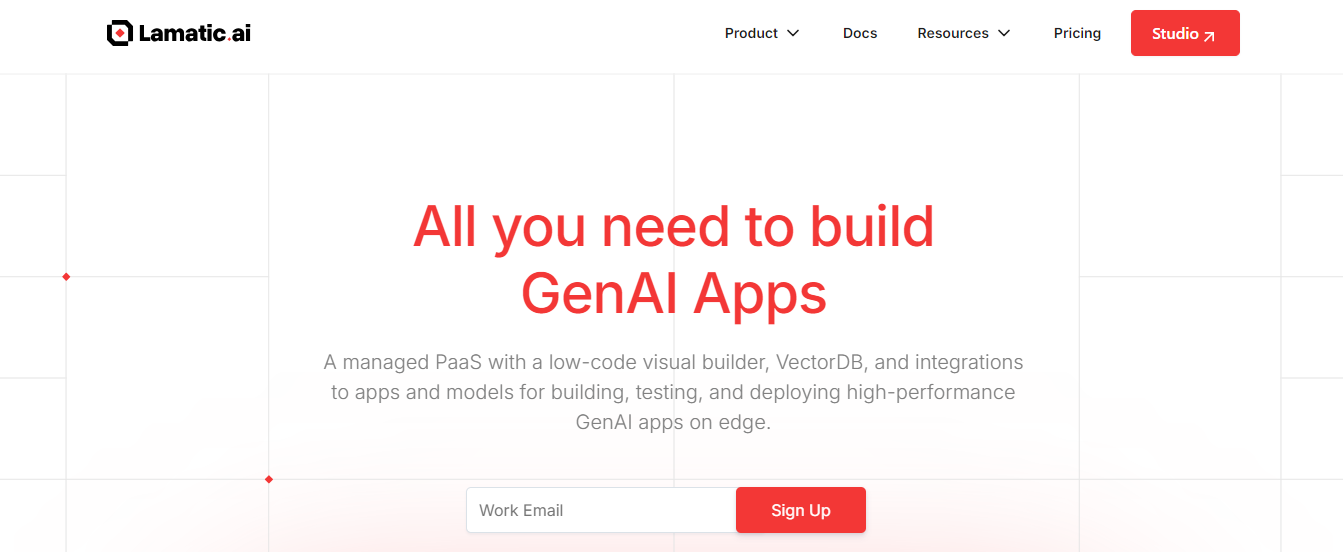Imagine you're building a house. You've already laid the foundation; now it's time to frame the structure. You have several options: wood, steel, or concrete. Each material has pros and cons, and some will be better suited for your project than others. Choosing the right one is critical to the durability and longevity of your home. Similarly, integrating multi-agent AI into your AI stack can enhance collaboration between different AI models, improving automation and decision-making. You must first select the proper framework to build an optimized, efficient, and scalable AI stack that enhances performance and simplifies development. In this article, we'll compare Haystack vs Langchain to help you make an informed decision.
Lamatic's generative AI tech stack will help you select the best framework for your project to build a robust AI stack quickly.
What are Haystack and Langchain, and What is Their Core Philosophy?

LangChain: The Framework that Makes AI Apps Simple
LangChain is an open-source Python framework that uses LLM interactions, real-time data processing, and other functionalities to build AI applications. Building AI apps is complex, and LangChain’s APIs, tools, and libraries simplify the process with:
- Prompt templates
- Vector store
- Retrievers
- Indexes
- Agents
Bridging the Gap
Like the name sounds, LangChain, the framework helps developers frame different LLMs together to build complex AI applications. Let's understand it this way: LLMs can't act to perform actions to complete a task. For example, ChatGPT cannot do a web search to give you the current weather forecast in London or the latest smartphones released to help you select the best one.
Data Deficiencies
These LLMs are limited to their pre-trained data. Nonetheless, AI applications cannot function with only pre-trained data. It has to acquire and process real-time data to complete the task and produce the desired output. If you are building enterprise AI applications, it also needs to retrieve and augment your business-specific data to execute intended tasks.
For example, an AI customer chatbot will need access to external data sources that include customer buying history, product details, order details, and company policies to resolve customer queries with relevant and up-to-date information.
Bridging the Complexity
Most enterprises use the RAG technique to build such AI apps. Nevertheless, building AI apps using RAG is not a piece of cake. Ask a developer about the steps involved in building an AI app or AI agent from scratch. It’s mind blogging! LangChain bridges the gap between a developer and AI app development by offering state-of-the-art tools and features to build next-gen AI applications.
Simplified AI Development
It simplifies the entire process so you don’t have to code the little details. You can simply use its components and tools to customize your AI agents or apps per your business needs. From memory library to vector store and prompt library, the framework has all it takes for you to build an AI app that’s efficient, faster, and accurate.
Synergy and Customization
Another good thing about LangChain is its ability to integrate several language models. This enables the AI app to understand and generate human-like language. Plus, the modular structure allows you to customize the app to your business needs smoothly. LangChain is the most preferred framework along with these advantages:
- Streamlining the development process
- Improving accuracy, efficiency, and applicability across diverse sectors
Haystack: The Framework Built for Enterprise AI Apps

Haystack is an open-source Python framework for building AI apps using large language models. Its components and pipelines constitute its core, enabling you to build end-to-end AI apps using your desired language models, embedding, and extractive QA with their database of choice.
The framework is built on top of transformers that provide a high level of abstraction for AI app development with LLMs. This makes it easy for you to get started with NLP tasks. This was best for old NLP tasks, including:
- Semantic search
- Retrieval
- Extractive question-answering
Haystack's Realization
The rise of LLMs in 2023 made them realize the importance of creating composable components and simultaneously offering an ideal developer experience. That is why Haystack's extractive QA approach seemed to fail. This created the path to improvements within the framework and the release of Haystack 2.0.
Haystack's Revamp
Haystack 2.0 is an entirely new version of the framework that focuses on making it possible to implement composable AI systems that are easy to use, customize, extend, optimize, evaluate, and ultimately deploy to production. Plus, haystack 2.0 is more flexible and easier to use than LangChain.
Key Features of LangChain

Have a look at the notable features of LangChain:
Data-Aware
LangChain's data-aware feature allows developers to connect language models to external data sources seamlessly, enhancing model interactions' contextual understanding and relevance. By integrating with data sources, LangChain enables applications to provide more informed and personalized responses based on real-time information.
Agentic
LangChain empowers language models to act as agents interacting with their environment, enabling dynamic and interactive applications that respond intelligently to user inputs. This feature enhances language models' adaptability and responsiveness, making them more versatile in various application scenarios.
Standardized Interfaces
LangChain offers standardized interfaces that ensure consistency and ease of integration for developers. These interfaces provide a uniform way to interact with different framework components, simplifying the development process and promoting interoperability with other tools and systems.
External Integrations
LangChain provides pre-built integrations with external tools and frameworks, allowing developers to seamlessly leverage existing resources and functionalities. This feature accelerates development timelines by reducing the need to build custom integrations from scratch, enabling faster deployment of language model applications.
Prompt Management and Optimization
LangChain facilitates efficient prompt management, enabling developers to optimize prompts for better model performance and output quality. By providing tools for prompt optimization, developers can fine-tune interactions with language models to achieve desired results and enhance user experiences.
Repository and Resource Collections
LangChain offers a repository of valuable resources and collections to support developers in developing and deploying language model applications. These resources include datasets, models, and tools that can aid in building robust and practical applications using LangChain.
Visualization and Experimentation
LangChain provides developers with visualization tools to explore and experiment with chains and agents. This feature allows developers to visualize the interactions between components, test various prompts, models, and chains, and iterate on their designs to optimize performance and functionality.
Key Features of Haystack 2.0
An insight into the notable features of Haystack 2.0.
Support for Diverse Data Structures
Haystack 2.0 introduces new data structures like the document structure, document store, streaming chunk, and chat messages, enhancing the framework's ability to manage various data efficiently. These structures enable better organization and retrieval of data, improving the overall performance and flexibility of data processing tasks within the pipeline.
Specialized Components
Haystack 2.0 provides specialized components tailored for tasks such as:
- Data processing
- Embedding
- Document writing
- Ranking
These components offer targeted functionalities to streamline pipeline customization, allowing developers to fine-tune each workflow stage for optimal performance and results.
Flexible Pipelines
Haystack 2.0 focuses on flexible pipeline structures that can adapt to diverse data flows and use cases. This flexibility allows developers to configure and customize the pipeline according to specific project requirements, ensuring the framework can accommodate various applications and data processing scenarios.
Integration with multiple model providers
Haystack 2.0 offers seamless integration with various model providers like Hugging Face and OpenAI, enabling users to leverage various models for experimentation and deployment. This compatibility with multiple providers expands the options available to developers, allowing them to choose the most suitable models for their specific use cases.
Data Reproducibility
Haystack 2.0 emphasizes data reproducibility by providing templates and evaluation systems for prompts. This enables users to replicate workflows and compare model outputs consistently. This focus on reproducibility ensures that results can be verified and compared across different experiments, enhancing the reliability and trustworthiness of the framework's performance.
Collaborative Community and Improvement
Haystack 2.0 fosters a collaborative community through initiatives like the Advent of Haystack, encouraging user feedback, contributions, and shared learning. This community-driven approach promotes continuous improvement and innovation within the framework, ensuring that Haystack evolves to meet the changing needs and challenges of the NLP community.
Related Reading
- What is Agentic AI
- How to Integrate AI Into an App
- Generative AI Tech Stack
- Application Integration Framework
- Mobile App Development Frameworks
- How to Build an AI app
- How to Build an AI Agent
- Crewai vs Autogen
- Types of AI Agents
Decoding Haystack vs LangChain Similarities and Differences

Detailed Comparisons:
Framework Features: Haystack vs. LangChain
Haystack and LangChain share several features, such as document retrieval, orchestration of AI workflows, and LLM integration. Both frameworks allow you to build applications that retrieve and process documents using LLMs to answer questions or summarize content.
Specialization Versus Versatility
The two frameworks also offer robust workflows that let you define modular processes for how different components interact. Nevertheless, Haystack focuses on information retrieval and search applications, while LangChain offers more flexibility for general use cases in LLM applications.
Key Features Comparison
Haystack and LangChain are designed to help developers build applications that use LLMs to process and generate human-like text. Under the hood, both frameworks offer similar capabilities, but they serve different use cases and have unique features that cater to their target audiences.
Integration and Extensibility
LangChain's Integration Capabilities Shine
LangChain shines when it comes to integration. The framework is designed flexibly, making integrating various models and tools into a single workflow easy. Whether using pre-trained or custom-built models, LangChain’s modular architecture allows you to connect different components seamlessly.
Seamless Chaining
For example, in one of my NLP projects, I needed to integrate a sentiment analysis model with a topic modeling tool. LangChain made this process straightforward. I could easily chain these models together, ensuring they worked harmoniously without spending too much time on configuration.
Effortless Expansion
Extensibility is another area where LangChain excels. If you need to add or customise new functionalities, LangChain’s well-documented API and modular design make it a breeze. You can extend its capabilities by writing custom components and integrating them into your existing pipeline without hassle.
Haystack's Focused Architecture
On the other hand, Haystack is also impressive in terms of integration and extensibility, but its focus is more on search and information retrieval. I’ve used Haystack to build search systems that needed to pull data from various sources, and it handled the integration smoothly.
Data Harmony
For instance, in an e-commerce project, I needed to integrate product information from different databases and external APIs. Haystack’s connectors and pipelines allowed me to fetch, index, and query data effortlessly. Extending Haystack is equally convenient. Its plugin-based architecture means you can add new features or improve existing ones without disrupting the core system.
This is particularly useful when scaling your search system or adding specialized functionalities.
Performance and Scalability
LangChain Optimized for Speed
Performance is crucial in any NLP application, and LangChain doesn’t disappoint. I’ve noticed that LangChain is optimized for speed and efficiency, allowing it to handle complex language processing tasks with minimal latency. This is especially important when dealing with real-time applications where every millisecond counts.
LangChain’s Scalability for Growing Data Demands
LangChain's other strong suit is its Scalability. I’ve worked on projects where the data volume grew exponentially, and LangChain scaled effortlessly to meet the demands. Its distributed processing capabilities ensure that you can scale horizontally, adding more resources as needed to handle larger datasets or more intensive processing tasks.
Haystack Built for Fast Search
Haystack is built with performance and scalability at its core. In my experience, Haystack delivers fast search results even when dealing with massive datasets. This is because it’s optimized to leverage efficient indexing and querying techniques, significantly reducing search times.
Adaptive Growth
Scalability is a key feature of Haystack. I’ve had instances where the user base for a search application increased dramatically, and Haystack scaled smoothly to accommodate the higher load. Its ability to distribute the workload across multiple nodes ensures that the system remains responsive and efficient, regardless of the scale.
Community and Support
LangChain's Community Support
Community support is vital for any open-source project, and LangChain has a vibrant and active community. The community is always willing to help, whether you’re a newbie or an experienced developer. The documentation is comprehensive, with plenty of examples and tutorials to get you started.
LangChain’s forums and chat groups are great places to seek advice, share experiences, and collaborate on projects. The developers are responsive and open to feedback, which means the framework continuously improves based on user input.
Haystack's Strong Documentation
Haystack also boasts a strong community and excellent support. When I started using Haystack, I was impressed by the quality of the documentation and the resources available. The community forums are active, and you can find answers to most of your questions there.
Haystack has a range of tutorials and example projects that can help you get up to speed quickly. The developers are engaged with the community, ensuring that issues are addressed promptly and that the framework evolves based on user needs.
Use Cases for LangChain
Specific Scenarios
I’ve worked on various NLP projects where LangChain truly shined. One memorable project was developing a sophisticated customer service chatbot for a financial services company. The chatbot needed to understand and process complex queries, handle sensitive information securely, and provide accurate responses quickly.
Integrated Intelligence
LangChain’s ability to integrate multiple language models allowed us to create a system that could perform sentiment analysis, entity recognition, and contextual understanding seamlessly. This made the chatbot efficient and reliable in handling intricate customer interactions.
Another scenario where LangChain excels is in creating automated content generation systems. For instance, we needed to generate personalized email content for thousands of users in a marketing campaign.
Personalized Precision
Using LangChain, we could chain models for user profiling, content creation, and sentiment analysis to ensure each email was tailored to the recipient’s preferences. This significantly boosted our campaign’s effectiveness and engagement rates.
Industries
LangChain is incredibly versatile and finds applications across various industries:
- Finance: As I mentioned, financial services benefit greatly from LangChain’s capabilities. Automated customer service, fraud detection, and financial advisory bots are some applications where LangChain excels.
- Healthcare: I’ve seen LangChain used to develop systems that can process and analyze patient data, provide medical recommendations, and even assist in diagnostics by integrating multiple medical knowledge databases and NLP models.
- Marketing and Advertising: Personalized marketing campaigns, customer sentiment analysis, and automated content generation are areas where LangChain’s modular approach proves highly effective.
- E-commerce: LangChain helps in creating intelligent product recommendation systems, personalized shopping experiences, and efficient customer support bots.
Use Cases for Haystack
Specific Scenarios
Haystack’s strength lies in efficiently handling search and information retrieval tasks. I’ve worked on projects where we needed to build powerful search engines for large content repositories. For example, at a media company, we implemented Haystack to create a search system that could quickly index and retrieve articles, videos, and other content types.
The performance and accuracy of Haystack’s search capabilities significantly enhanced the user experience, allowing users to find relevant content with ease. Another scenario where Haystack excels is in building enterprise search solutions.
Enterprise Insight
In a project for a large corporation, we used Haystack to develop an internal search system that could index millions of documents from various departments. The system enabled employees to find necessary information swiftly, boosting productivity and collaboration within the organization.
Industries
Haystack is particularly well-suited for the following industries:
- Media and Publishing: As I experienced, media companies benefit from Haystack’s ability to handle large volumes of content and provide fast, relevant search results. It’s ideal for building robust content discovery platforms.
- E-commerce: Haystack’s search capabilities are invaluable for e-commerce platforms, where customers need to find products quickly and accurately. It supports features like faceted search, autocomplete, and personalized search results.
- Enterprise: In large organizations, Haystack helps create robust internal search systems that can index vast documents and data, improving knowledge management and operational efficiency.
- Healthcare: Haystack can be used to build search systems for medical databases, enabling quick access to research papers, patient records, and other critical information.
Related Reading
- Llamaindex vs Langchain
- LLM Agents
- LangChain vs LangSmith
- Langsmith Alternatives
- LangChain vs RAG
- Crewai vs Langchain
- AutoGPT vs AutoGen
- GPT vs LLM
- AI Development Tools
- Rapid Application Development Tools
Start Building GenAI Apps for Free Today with Our Managed Generative AI Tech Stack

Lamatic offers a managed generative AI tech stack that automates workflows and provides production-grade deployment for applications needing to integrate AI capabilities. The platform's features include:
Managed GenAI Middleware
Middleware connects disparate software programs and applications. Lamatic’s managed GenAI middleware offers easy integration for generative AI capabilities, enabling systems to communicate with each other and eliminating costly tech debt.
Custom GenAI API: GraphQL
Lamatic provides a customizable GenAI API that allows users to tailor functionality to their needs. The GraphQL format is easy to use, allows for rapid development, and enables faster GenAI integrations.
Low Code Agent Builder
Lamatic includes a low-code agent builder that helps users create customized GenAI solutions without extensive programming knowledge. This feature simplifies and accelerates the development process for GenAI applications.
Automated GenAI Workflow (CI/CD)
Lamatic automates the continuous integration and continuous deployment workflows for GenAI applications. This feature eliminates manual processes for deploying and updating GenAI applications to ensure teams can build and deploy production-grade systems that integrate generative AI quickly and efficiently.
GenOps (DevOps for GenAI)
GenOps applies DevOps principles to the development of GenAI applications. This approach focuses on collaborative, efficient, and automated workflows to help teams build GenAI applications faster and with fewer resources.
Edge Deployment via Cloudflare Workers
Lamatic enables fast, efficient deployment of GenAI applications at the edge. This means that applications can be hosted closer to the end user for improved performance and user experience. Cloudflare workers, which Lamatic uses for edge deployment, are serverless functions that run on Cloudflare’s global network.
Integrated Vector Database (Weaviate)
Weaviate is an open-source vector database that stores unstructured data for AI applications. Lamatic’s integration of Weaviate enables rapid data retrieval to improve the performance of GenAI applications.
Related Reading
- Best No Code App Builders
- LLM vs Generative AI
- Langchain Alternatives
- Autogen vs Langchain
- Langflow vs Flowise
- SLM vs LLM
- Langgraph vs Langchain
- Semantic Kernel vs Langchain
- UiPath Competitors
- Agentic Definition
- AI Developers
- Best AI Models
- Best AI Coding Assistant
- LangChain Agent
- Best AI Code Generator
- AI Developer Tools





